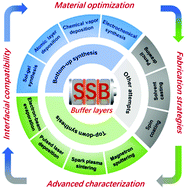Recent advances in the interface engineering of solid-state Li-ion batteries with artificial buffer layers: challenges, materials, construction, and characterization†
Abstract
Although solid-state Li-ion batteries (SSBs) provide opportunities to simplify safety measures (e.g., sophisticated thermal management systems, overpressure vents, charge interruption devices) currently used in conventional Li-ion batteries (LIBs) with flammable organic liquid electrolytes, the poor interface compatibility (both physically and chemically) between the electrode materials and solid electrolyte strongly hinders the practical application of SSBs. The fabrication of artificial buffer layers (ABLs) was therefore proposed, and it has been an effective approach for overcoming the interface issues of SSBs. In this review paper, we provide a comprehensive summary of recent progress in interface engineering and advanced techniques for characterization of such interfaces in SSBs. First, the critical issues and challenges facing SSBs associated with the stability of the cathode/solid electrolyte and anode/solid electrolyte interfaces are discussed. The latest research approaches and synthetic strategies to improve the performance of SSBs that rely on interface engineering with ABLs are extensively reviewed. The characterization strategies for in situ and ex situ interfacial observation and analysis are comprehensively summarized. Finally, the critical issues associated with electrode–electrolyte interfaces are emphasized, and perspectives regarding the development of high-quality buffer layers are presented.



 Please wait while we load your content...
Please wait while we load your content...